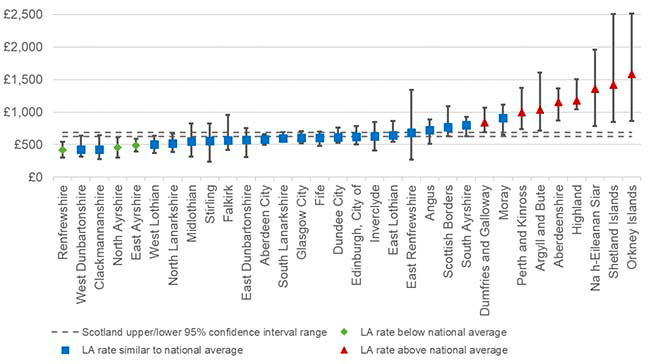Scottish House Condition Survey: Local Authority Analysis 2017-2019
Local Authority figures for 2017-2019, including fuel poverty rates, energy efficiency ratings, the condition of housing and the Scottish Housing Quality Standard.
This document is part of a collection
Fuel Poverty Gap
Where a household is in fuel poverty, the fuel poverty gap is the annual amount that would be required to move the household out of fuel poverty. The median fuel poverty gap before adjustment presents the actual amount that fuel poor households require to move out of fuel poverty. The adjusted median gap figures, adjusted to 2015 prices, have been presented in order to assess progress against the 2040 fuel poverty gap target of £250 (in 2015 prices). The adjustment has been made in alignment with the increases or decreases in the annual average Consumer Price Index (CPI).
In the period 2017-2019, the median fuel poverty gap was generally higher in island and rural local authorities and, across all local authorities, ranged from £440 (Clackmannanshire and Renfrewshire) to £1,640 (Orkney Islands) with a national average of £690.
The median fuel poverty gap adjusted for 2015 prices varied from £420 in Clackmannanshire to £1,580 in Orkney Islands with a national average of £650 (Figure 7). As with the actual median fuel poverty gap, the adjusted median fuel poverty gap was generally higher in island and rural local authorities.
Margins of error are wide for some local authorities due to a variety of reasons. The sample sizes are limited as they are restricted to fuel poor households responding to the survey; ranging from 30 households in East Renfrewshire to 155 households in Glasgow City across the three-year period of 2017-2019. Samples sizes in the three island local authorities which had the highest median fuel poverty gaps (adjusted for 2015 prices) were: 108 (Na h-Eileanan Siar), 80 (Orkney Islands) and 84 (Shetland Islands). In addition, variations in fuel bills and/or household income across different household characteristics can influence the median gap distribution. This is especially relevant in remote rural and island areas where the range of uplifts applied to the UK Minimum Income Standard (MIS), dependent on household size, can lead to a wider range in median fuel poverty gap.

Note: In this chart, the fuel poverty median gap (adjusted for 2015 prices) for Scotland as a whole is a three-year average. This is different to that published in the main SHCS Key Findings report, which is an annual figure. Unlike the other charts in this report, the colour coding is based simply on whether confidence intervals overlap; this is because this measure is a median and cannot be significance tested in the same way as a mean.
Contact
Email: shcs@gov.scot
There is a problem
Thanks for your feedback